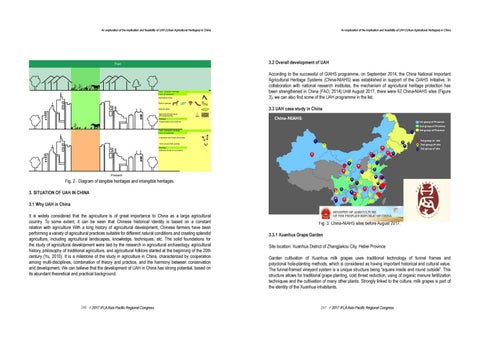An exploration of the implication and feasibility of UAH (Urban Agricultural Heritages) in China
An exploration of the implication and feasibility of UAH (Urban Agricultural Heritages) in China
3.2 Overall development of UAH According to the successful of GIAHS programme, on September 2014, the China National Important Agricultural Heritage Systems (China-NIAHS) was established in support of the GIAHS Initiative. In collaboration with national research institutes, the mechanism of agricultural heritage protection has been strengthened in China (FAO, 2014).Until August 2017, there were 62 China-NIAHS sites (Figure 3), we can also find some of the UAH programme in the list. 3.3 UAH case study in China
Fig. 2. Diagram of tangible heritages and intangible heritages. 3. SITUATION OF UAH IN CHINA 3.1 Why UAH in China It is widely considered that the agriculture is of great importance to China as a large agricultural country. To some extent, it can be seen that Chinese historical identity is based on a constant relation with agriculture With a long history of agricultural development, Chinese farmers have been performing a variety of agricultural practices suitable for different natural conditions and creating splendid agriculture, including agricultural landscapes, knowledge, techniques, etc. The solid foundations for the study of agricultural development were laid by the research in agricultural archaeology, agricultural history, philosophy of traditional agriculture, and agricultural folklore started at the beginning of the 20th century (Yu, 2010). It is a milestone of the study in agriculture in China, characterized by cooperation among multi-disciplines, combination of theory and practice, and the harmony between conservation and development. We can believe that the development of UAH in China has strong potential, based on its abundant theoretical and practical background.
246 l 2017 IFLA Asia Pacific Regional Congress
Fig. 3. China-NIAHS sites before August 2017. 3.3.1 Xuanhua Grape Garden Site location: Xuanhua District of Zhangjiakou City, Hebei Province Garden cultivation of Xuanhua milk grapes uses traditional technology of funnel frames and polyclonal hole-planting methods, which is considered as having important historical and cultural value. The funnel-framed vineyard system is a unique structure being “square inside and round outside�. This structure allows for traditional grape planting, cold threat reduction, using of organic manure fertilization techniques and the cultivation of many other plants. Strongly linked to the culture, milk grapes is part of the identity of the Xuanhua inhabitants.
247 l 2017 IFLA Asia Pacific Regional Congress
